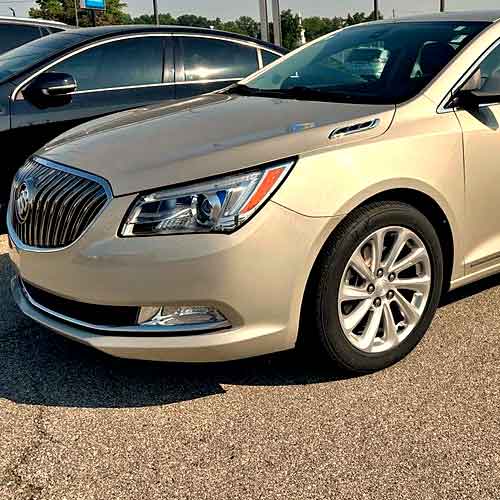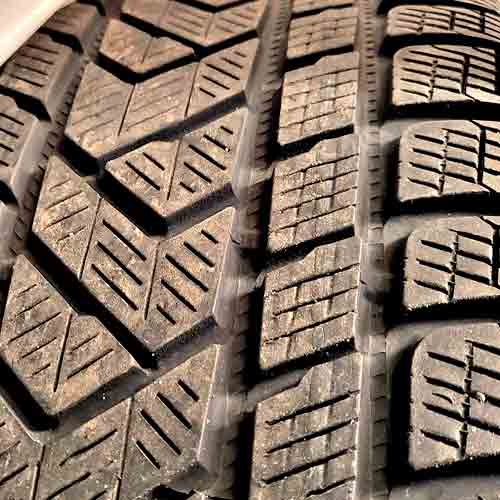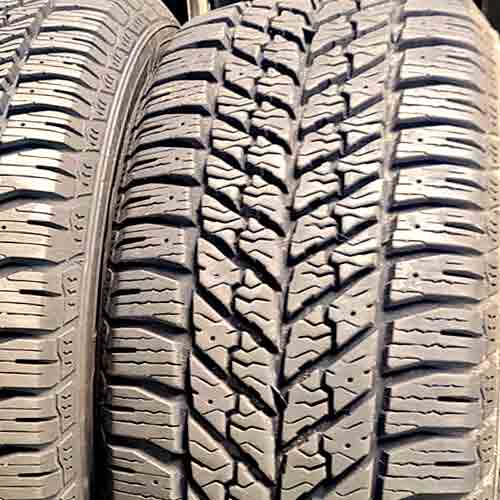Both Pirelli Scorpion Winter and Goodyear UltraGrip are snow-taming beasts in the winter tire market, each offering a unique set of capabilities to face the harshest weather conditions. Let’s see which tire is better for you.

Table of Contents
Key Takeaway
Goodyear UltraGrip takes the lead when it comes to:
- Snowy conditions due to wider tread voids and efficient V-shaped lugs.
- Handling in dry conditions thanks to stiffer rubber and quick steering response.
- Fuel economy, achieving comparable efficiency as Pirelli due to its stiffer compound.
On the other side, Pirelli Scorpion Winter excels in:
- Ice performance with its expertly designed tread pattern and multi-angled sipes.
- Wet grip, attributed to its softer compound, dense siping, and effective hydroplaning-resistant grooves.
- Comfort levels: quieter rides due to fewer tread voids and superior variable pitch compound; better vibration dampening with its unique tread pattern and material blend.
Ice Performance
When faced with icy conditions, the Pirelli Scorpion Winter emerges as the top contender, with significantly shorter braking distances and faster acceleration times, as noted from averaged test results.

The tire offers an expertly designed tread pattern, featuring well-positioned biting edges at optimal angles.
The combination of slanted incisions and V-shaped biters, each facing both lateral directions, provides superior gripping capabilities on icy surfaces.
Additionally, the tire’s enhanced flexibility and multi-angled sipes further augment this gripping performance.
Conversely, the Goodyear UltraGrip, although possessing suitable grooves and ample sipes, misses the mark somewhat due to the absence of notches along its smoothed-out edges.
This results in less effective biting ability, especially in comparison to its counterpart.
So, overall, the Pirelli Scorpion Winter clearly takes the lead in icy conditions.
Though keep in mind, both tires aren’t so great on icy terrains, I mean there are far better options out there.
Snow Performance
When it comes to snowy conditions, however, the Goodyear UltraGrip takes the lead, thanks to its specific design features.

The tire offers wider tread voids and in-groove notches that help trap snow particles.
This design promotes better traction, as snow lodged in the grooves provides better grip than the rubber tread itself.
Furthermore, the tire’s divided up V-shaped lugs are highly efficient at displacing thick snow, enhancing forward momentum and contributing to superior acceleration times.
Basically acceleration is what’s giving this tire the main edge.
As the tire exit the corners, it reaches out towards the desired speeds quickly, adding to it’s overall handling times, as seen by lap tests.
In comparison, the Pirelli Scorpion Winter shows somewhat limited braking and handling capabilities due to less efficient design.
Meaning, its biters don’t effectively form the highly needed snow to snow contact, nor throw back the snow as effectively as the Goodyear.
Therefore, the Goodyear UltraGrip stands out as the better performer in snowy conditions.
Wet Grip
In terms of wet traction, two pivotal factors come into play: the design of the tread and the composition of the rubber compound.
Considering these factors, the Pirelli Scorpion Winter again takes the lead, even though both tires feature abundant siping throughout their treads to aid grip.
This advantage can be attributed to a lot of features, though most important ones are following.
- It offers a softer compound.
- It has more siping per square inch of its tread.
- It’s grooves offer better resistance to hydroplaning.
But how each is helping? Let me explain.
So with softer compound, the tire’s biters remain flexible, even while the tire is in aggressive turns for example. And since these slits suck up water particles (by flexing), their stretching ability is a crucial factor here.
Moreover, with its more efficient grooves throwing out more water at a given time (relatively), allows for superior resistance to hydro or aquaplaning, and it also means, there’s less burden for sipes (since groove handle majority of the work-load).
So overall, the Pirelli offers better overall wet performance compared to Goodyear.
Fuel Economy
Fuel economy is influenced by several factors, including the tire’s adherence to the road surface and its overall tread pattern.
Upon evaluating these elements, it’s clear that both tires exhibit similar rolling resistance values, leading to comparable miles per gallon (MPG).
Interestingly, this similarity in fuel efficiency is due to different reasons for each tire.
The Pirelli Scorpion Winter, although having a softer compound that leads to more lug flexing and hence extra energy consumption, is redeemed by its more streamlined arrangement of its ribs.
So you get rolling resistance (on average), which is equivalent to that of the Goodyear UltraGrip.
The Goodyear UltraGrip, although features less streamlined structure with its voids going everywhere, it’s stiffer compound is saving it, or should I say reserving its energy.
Basically it’s lugs with stiffer rubber don’t move a lot, even with extreme tire maneuvers, and this resisting of the lug flexing leads to similar fuel economy compared to its rival here.
Therefore, in terms of fuel economy, both tires perform on par with each other.
Dry Traction
Dry performance is broken down into two main components: grip and handling.
Grip pertains to the tire’s ability to roll, brake or corner, and here the straight line grip is typically measured using braking distances, while lateral grip is calculated by g forces.
Now in terms of grip, the Pirelli offers better traction values.
It’s central most rib forming interlocking lugs contribute to its superior directional grip, while its more compacted up shoulder lugs provide better sideways grip as well.
Though overall handling times on both tires are similar. This is because this performance metric combined both the grip and the tire’s steering response.
And Pirelli with softer rubber, and greater tread depth, isn’t so quick to respond to the driver’s input, as concluded from the multiple tests.
The tire basically is more prone to under-steer in comparison.
On the other hand, the Goodyear UltraGrip is taking the lead, as it’s stiffer rubber and more composed tread depth allows for smaller lug bending.
This smaller deformation of its tread leads to faster overall steering response. And the result? The tire in tests, offers half a second faster handling times in comparison.
So, to sum up, the Goodyear UltraGrip offers better overall handling, while the Pirelli Scorpion Winter provides you with greater dry grip.
Comfort Levels
The comfort level of a tire is largely determined by factors such as road noise and vibration absorption capability, which can vary significantly depending on the tire’s construction.
Let’s check out both factors.
Noise
Tire noise arises from the collision of air particles with tread patterns.
This auditory element plays a significant role, as particles first bump with the tread, and impact of that creates noise. Then that noise resonate within the tread walls, and create what they call, in-groove resonance.
Moreover, these add to the tire’s vibrations as well.
That’s why with more voided up structure, the Ultra Grip lacks here, allowing air more room to play around.
On the other hand, the Pirelli’s tread pattern, characterized by fewer voids, reduces spaces where air can reverberate, leading to quieter tire rotation.
So you get a more silent option here, elevating in-car comfort.
Moreover, Pirelli also offers superior variable pitch compound too. This basically creates various tones frequencies at the same time, and those then don’t get amplified this way.
So overall you get a quieter ride with Scorpion tire.
Road Bumps
Tires act as the first line of defense against the roughness of roads, with their capacity to nullify vibrations from uneven terrains directly impacting ride quality.
In this domain, the Scorpion Winter shines, all thanks to it’s distinctive tread pattern and material blend which allow it with superior vibration-dampening properties.
When faced with road anomalies like potholes, the tire’s design adeptly cushions these disturbances, offering a seamless ride and reducing vibrations felt within the vehicle.
Conversely, while the Goodyear provides commendable vibration dampening, it falls slightly short here still, primarily due to its more rigid outermost cap ply.
So impact comfort performance is better on Pirelli.
Conclusion
Both tires have their strengths and weaknesses. Let me explain.
The Pirelli Scorpion Winter excels in icy conditions, wet traction, and comfort levels.
Its superiority in icy terrains is due to its well-constructed tread pattern and enhanced flexibility.
For wet roads, its softer compound, combined with efficient groove design and increased siping, ensures optimal water dispersion.
Moreover, its fewer tread voids and unique variable pitch compound contribute to a quieter ride, and its design is adept at cushioning road disturbances, enhancing overall comfort.
On the other hand, the Goodyear UltraGrip stands out in snowy conditions, with its ability to trap snow particles and provide impressive acceleration, and it also has the edge in dry handling responsiveness due to its stiffer rubber and tread design.
In terms of fuel economy, both tires are on par, each attributing their efficiency to different design elements.
So, when choosing between the two, it really comes down to your specific driving conditions and needs.